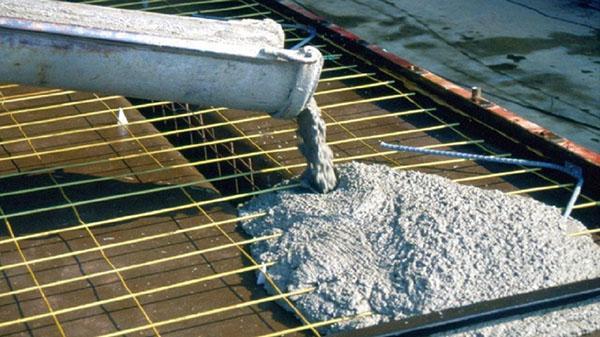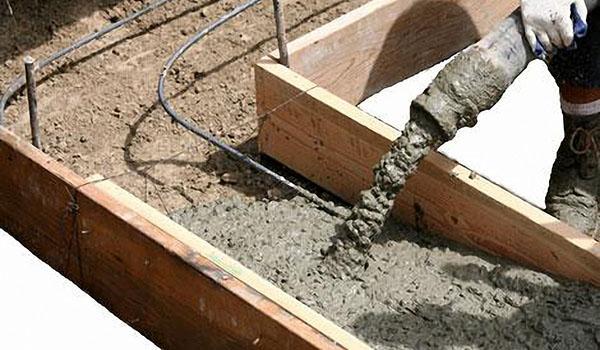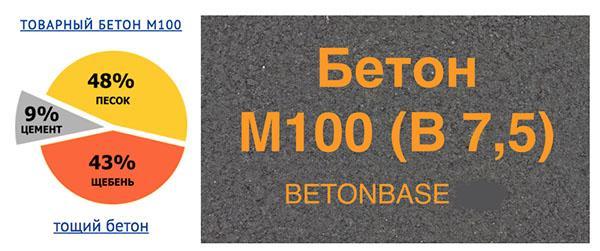Choosing concrete for the foundation: all the subtleties and nuances of work
 As you know, a properly poured foundation provides strength and reliability to the house installed on it. Therefore, choosing the right concrete for the foundation is an important part of a successful construction. Depending on the proposed building, choose the brand of concrete mix. An important role in this is played by the estimated weight of the building, its number of storeys and even its intended purpose. However, having correctly selected the grade of concrete, you should also perform the batch in a dignified manner so that the product properties specified by the manufacturer in the technical specifications are not lost.
As you know, a properly poured foundation provides strength and reliability to the house installed on it. Therefore, choosing the right concrete for the foundation is an important part of a successful construction. Depending on the proposed building, choose the brand of concrete mix. An important role in this is played by the estimated weight of the building, its number of storeys and even its intended purpose. However, having correctly selected the grade of concrete, you should also perform the batch in a dignified manner so that the product properties specified by the manufacturer in the technical specifications are not lost.
Choice by marking: differences and purpose

- M100.
- M150.
- M200.
- M250.
- M300.
- M400.
Variations are possible within the same group. These mixtures differ in purpose and strength. The grade of the foundation solution is determined depending on the design plan of the structure being erected.
M100
 The weakest solution. The concrete mix prepared from this grade of concrete can be used as a basis for fence, for the construction of small lightweight structures, such as wooden ones. This brand of concrete is not suitable for building the foundation of a private house, even a one-story one. You can use this brand in the construction of small garages intended for agricultural use. The estimated load on the building, when establishing a foundation from this grade of concrete, should be minimal or absent altogether.
The weakest solution. The concrete mix prepared from this grade of concrete can be used as a basis for fence, for the construction of small lightweight structures, such as wooden ones. This brand of concrete is not suitable for building the foundation of a private house, even a one-story one. You can use this brand in the construction of small garages intended for agricultural use. The estimated load on the building, when establishing a foundation from this grade of concrete, should be minimal or absent altogether.
M150
 This brand of concrete can be used for preparatory work when erecting a light strip foundation for a private house. When erecting light structures from cinder block, aerated concrete or foam concrete, concrete of this brand can also be used. Only one-story buildings are allowed. You can use this brand of concrete in the construction of garages, agricultural premises, provided that the buildings are one-story.
This brand of concrete can be used for preparatory work when erecting a light strip foundation for a private house. When erecting light structures from cinder block, aerated concrete or foam concrete, concrete of this brand can also be used. Only one-story buildings are allowed. You can use this brand of concrete in the construction of garages, agricultural premises, provided that the buildings are one-story.
M200
 This brand of concrete mixes is designed to create concrete products. It is used to create floor slabs. According to its technical characteristics, this mixture is classified as structural (according to strength characteristics). To establish foundations, you can use this grade of concrete if you plan a light type of floor in the structure being built. In this case, the building being erected can have either one or two floors.
This brand of concrete mixes is designed to create concrete products. It is used to create floor slabs. According to its technical characteristics, this mixture is classified as structural (according to strength characteristics). To establish foundations, you can use this grade of concrete if you plan a light type of floor in the structure being built. In this case, the building being erected can have either one or two floors.
M250
 Used in the construction of private houses. It is this concrete that is recommended to be used for the foundation of a private house, regardless of its number of storeys (the strength allows one-story, two-story and even three-story housing structures to withstand, in the absence of additional load on the structure). The areas of houses being built can be different, the target purpose of the structures being built is housing.
Used in the construction of private houses. It is this concrete that is recommended to be used for the foundation of a private house, regardless of its number of storeys (the strength allows one-story, two-story and even three-story housing structures to withstand, in the absence of additional load on the structure). The areas of houses being built can be different, the target purpose of the structures being built is housing.
M300
 Concrete mixes of this brand are recommended to be used to create monolithic floors.Its strength characteristics indicate the possibility of using this mixture when pouring the foundation of residential buildings, cottages and buildings, the number of storeys of which varies from three to five floors. Large private houses with a heavy load, even their number of storeys does not reach three, it is also recommended to build on concrete of this brand.
Concrete mixes of this brand are recommended to be used to create monolithic floors.Its strength characteristics indicate the possibility of using this mixture when pouring the foundation of residential buildings, cottages and buildings, the number of storeys of which varies from three to five floors. Large private houses with a heavy load, even their number of storeys does not reach three, it is also recommended to build on concrete of this brand.
M400
 Erection of structures on a concrete foundation made of M400 is advisable when erecting structures with a number of storeys exceeding five floors. When constructing residential complexes, or some other premises, the use of concrete of this brand is possible with the planned building height of up to twenty floors.
Erection of structures on a concrete foundation made of M400 is advisable when erecting structures with a number of storeys exceeding five floors. When constructing residential complexes, or some other premises, the use of concrete of this brand is possible with the planned building height of up to twenty floors.
How to prepare concrete for a foundation
 Depending on the selected concrete grade, the proportions of the ingredients are determined when mixing the concrete mixture. It is worth noting that different foundations - tape, pile, slab and others - require different techniques for working with the foundation. When mixing concrete for the foundation, in addition to the cement powder itself, the following ingredients should be in large quantities:
Depending on the selected concrete grade, the proportions of the ingredients are determined when mixing the concrete mixture. It is worth noting that different foundations - tape, pile, slab and others - require different techniques for working with the foundation. When mixing concrete for the foundation, in addition to the cement powder itself, the following ingredients should be in large quantities:
- Water. It must be clean. It is advisable to use drinking water, or taken from a well. The cleaner the water is, the better the mortar adhesion in the end. It is unacceptable to use water contaminated with soil, sand, clay, leaves falling from trees and other debris. All this has a detrimental effect on the final result of the finished cement mixture and, as a result, the strength of the poured foundation deteriorates. When erecting buildings with an assumed high load, deterioration of the strength of the foundation can be fatal.
- Sand. Just like water, it must be clean. There should be no foreign impurities, especially from clay. Sand contaminated with soil, clay, small debris and other debris can greatly affect the strength of the concrete mix. If possible, sift the sand before placing it in the concrete mixer. This will partially facilitate the work of the concrete mixer, and will also separate the sand from small and large impurities.
- Crushed stone. It is necessary to use either gravel of 1-1.5 cm calibration, or gravel. When using crushed stone, it is necessary that the fraction of crushed stone is the same, and its distribution in the mixture is uniform.
Since, unlike cement, sand is often not possible to store in dry rooms with good ventilation (it is stored outside), it easily absorbs moisture from dew, rain and air. This means that when calculating the proportions of concrete for the foundation, the water contained in the moisture of the sand must also be taken into account.
Depending on the volume of a one-time batch of the mixture, it is necessary to take up to several liters of water and reduce the rate of putting it into the concrete mixer.
Calculating the proportion of the mixture
 Mixing the mortar for pouring the foundation must necessarily be done in a concrete mixer - the volume of concrete mixture required for pouring the foundation cannot be mixed quickly manually, and the quality of the mortar mixed with shovels is much worse and is not suitable for installing the foundation.
Mixing the mortar for pouring the foundation must necessarily be done in a concrete mixer - the volume of concrete mixture required for pouring the foundation cannot be mixed quickly manually, and the quality of the mortar mixed with shovels is much worse and is not suitable for installing the foundation.
Particular attention must be paid to the cement. How to choose a brand of cement, depending on the purpose of the building being built, was described in the section above. Although a more aggressive mortar will be more expensive in terms of cost, since the brand is more expensive and its proportion in the finished mixture is greater, the building will meet design and engineering requirements. Due to the observance of these rules, the load on the building will correspond to the expected one, and this, in turn, ensures the safety of people who work, live or spend leisure time in the erected structure. It is desirable that the cement powder is fresh.
You should buy bags no earlier than 1-1.5 weeks before you start working with it.
It easily absorbs moisture and, as a result, loses its properties. The cement included in the concrete for the foundation must be dry, free-flowing, homogeneous.This means that bags should not be stored outdoors, but in dry and well-ventilated areas.
Here is an approximate calculation of the required ingredients for M300 or M400 concrete:
10 kg of cement + 30 kg of sand + 40-50 kg of fine crushed stone.
This is the weight of the bulk ingredients. Thus, approximately 80-90 kg of dry bulk mixture is obtained for the preparation of a solution. Water is needed by weight in half less than the weight of bulk ingredients:
(10 kg of cement + 30 kg of sand + 40-50 kg of fine crushed stone) / 2 = 40-45 liters of clean water.
When adding water, it should be borne in mind that the solution must be sufficiently dense. It is better to use less water and gradually introduce it into the solution.
For the convenience of work, it is advisable to lead a hose to the place of work with a concrete mixer.
In this article, the proportions and calculations of the preparation of concrete for the foundation were given. A description of the different brands of cement will help you choose the right mix.
Pouring foundations. It is necessary to calculate the materials correctly. This concrete mix can withstand the loads of multi-storey buildings. But more often they are used for foundations for a garage, a bathhouse, a shed, one-story houses. Thanks to this brand, foundations can be poured in areas with difficult terrain.